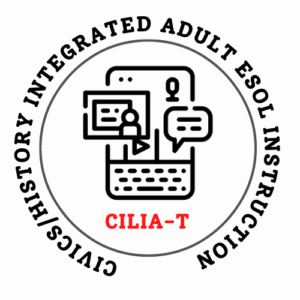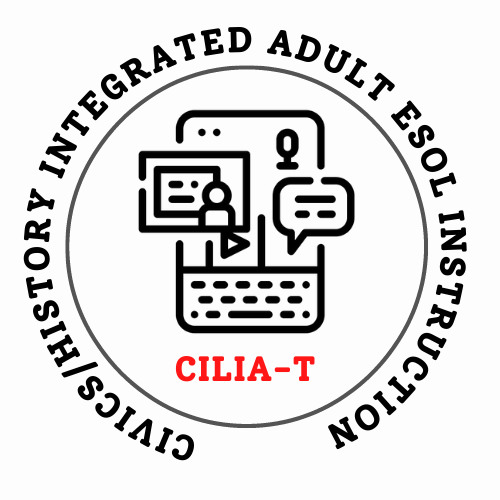- MN ABE Connect
- Archive
- CILIA-T Curriculum Project: Developing Our Digital Skills Roadmap
 January 30, 2023
January 30, 2023
CILIA-T Curriculum Project: Developing Our Digital Skills Roadmap
Nell Eckersley, Senior Advisor to the NYC Support and Technical Center (STAC) Leah Hauge, Aydin Durgunoglu, and Erin CaryWhat is the CILIA-T Project?
 CILIA-T stands for Content-Integrated Language Instruction for Adults with Technology Support. Our goal is to develop a curriculum that integrates Civics, US History and English instruction enhanced by digital resources and activities. It is designed for intermediate-level adult English learners, enabling them to develop their English proficiency, build their knowledge of U.S. history and civics, and work towards accomplishing their goals, such as participating more fully in their communities, gaining citizenship and improving their employment and educational opportunities.
CILIA-T stands for Content-Integrated Language Instruction for Adults with Technology Support. Our goal is to develop a curriculum that integrates Civics, US History and English instruction enhanced by digital resources and activities. It is designed for intermediate-level adult English learners, enabling them to develop their English proficiency, build their knowledge of U.S. history and civics, and work towards accomplishing their goals, such as participating more fully in their communities, gaining citizenship and improving their employment and educational opportunities.
Here are some features of the curriculum our content and technology teams are building and will pilot within the next 1-2 years:
- 16 modules, designed with the idea that each module can be covered in about a week
- Engages U.S. history and civics content through a thematic lens, with deep processing of texts and multimodal materials
- Broadens academic vocabulary, morphological skills, and critical thinking and application
- Focuses on digital literacy skills as part of instruction
- Teachable in person and via hybrid and remote delivery models, both on computers and mobile devices
- Includes detailed teacher resources and curriculum guides
- Provides materials aligned with current ABE content standards
- Developed by a team of adult educators
- The best news for educators: the entire curriculum will be available online for free
Our focus in this article is to describe how the Digital Literacy Skills Team is developing a roadmap of the digital skills learners will learn and use throughout the CILIA-T modules. Although the very first module will introduce the basics of digital literacy skills, these skills will be practiced and further developed throughout the entire curriculum. Consequently, we needed to determine which tools to use and which digital skills to cover.
Our Process
To design our digital skills roadmap, we considered three topics:
- Digital literacy standards and frameworks that had already been developed.
- The particular digital literacy tools and skills that will be needed throughout the CILIA-T curriculum.
- The foundational digital literacy skills we identified as necessary for learners to effectively engage with the digital tools.
Identifying the Digital Tools
Over the course of several meetings, our team considered the following issues to help us decide on the basic digital skeleton of CILIA-T and the foundational digital literacy skills that the learners would need to successfully complete the course.
- Which delivery method will the course use?
Hybrid, both in-person classwork (that can be delivered remotely as well) and individual homework activities using digital tools. - How will learners access the course online?
All materials will be available for free on a website. - What will onboarding look like for newly enrolled learners?
Whole class onboarding to new digital literacy tools using the first module, and continued digital skill building across the remaining modules. - How will the instructor communicate with learners? How will the learners receive feedback on their learning?
In person, and using email, messaging apps and automated responses on the digital tools. - Who will the learners contact if they have trouble with the course? How will they reach out?
Mainly the instructor (in person, email, messaging apps). - Will there be multimodal content?
Yes, via visuals, videos and audio files in addition to texts. - What will learners need to access the course?
Learners will set up/utilize a personal email account and accounts on several digital tools with instructor support. - What kinds of activities will learners need to complete as part of the instruction?
Learners will read texts, answer questions, use multimodal resources, make presentations, create and share content, perform self-checks, comment on others’ work, engage in discussions and group projects, and complete internet searches and evaluations.
The digital skeleton described above guided our selection of the relevant digital tools. The digital tools selected needed to be mobile-compatible, free, easy to access and use, and capable of functioning for the specific purpose/s identified by the team. Through this process, we identified the following tools recommended for use in this curriculum.
- Flip: Learners and instructors may use Flip to create content in various formats (text, audio, video) and others can respond to the content, by writing comments or recording and sharing a video.
- Quizlet: Because vocabulary is an integral part of the curriculum, learners and instructors may use Quizlet to create and practice different sets of materials, such as vocabulary flashcards/quizzes. Learners can choose the mode of study appropriate for their goals and to do self-checks.
- Google Apps: Learners and instructors may use Google Apps to create, send, and reply to emails; collaborate with others in Google Docs.
- Whatsapp: Learners may use Whatsapp to send, receive, and respond to messages in different formats, including text, voice messages, and pictures.
- Video Conferencing Platforms: Learners may use video conferencing platforms to join a synchronous class meeting using a virtual meeting platform.
- Internet browsers: Learners may navigate to and access websites, in order to evaluate and use internet resources to gather information and to create and share content.
Digital Literacy Competencies
Digital literacy competencies define the overarching digital skills learners need in order to build digital resilience and digital literacy.
Given the curriculum goals, the digital tools selected to be used throughout the curriculum and tasks learners will complete, what are the digital literacy competencies that learners need to develop and use throughout the curriculum? The overarching digital skills that learners will work towards throughout the CILIA-T modules are listed below with a few examples of each digital skill:
- Functional Skill/Navigation Skills: Understanding the basics of search engines; performing internet search using clear parameters (terms and filters); and discerning relevant links from irrelevant ones offered by a search engine.
- Finding and Evaluating Digital Information: Determining the quality of information by identifying bias; and assessing the reliability of sources by incorporating strategies to evaluate the expertise and credibility of the author and/or publishing organization.
- Responsible Digital Citizenship: Communicating ideas clearly, politely, and with awareness of the audience using email, chat functions, or other digital messaging tools.
- Technology Troubleshooting: Problem-solving common technical issues encountered during virtual learning, including factors that may impact internet speed, audio and video issues; and managing notifications and settings for apps.
- Comprehension and Integration: Synthesizing relevant information from one or more online sources; integrating new information learned online to support understanding, views, perspectives, or opinions; and identifying the main ideas from online sources.
- Communication, Collaboration, and Creation: Managing contacts on a smartphone, including adding and removing contacts; collaborating with others in Google Docs by using suggestion mode to track changes, accept edits, and add and reply to comments; and responding to a Flip topic by writing a comment or recording and sharing a video.
Next steps
At this stage, our team is working to sequence the digital literacy standards that will be taught in the modules. The first module of instruction will include onboarding to the digital literacy tools. Additionally, we plan to create an interactive online tutorial that learners and instructors can access for additional support. Finally, we are designing an interactive online assessment to check for learner mastery of the digital standards and competencies.
The technology and content members of our team are working collaboratively to integrate digital literacy instruction into the language- and civics-focused lessons. We recognize that learners and teachers will need multiple opportunities to build digital skills throughout the course. Therefore, we’re adding routines in each module that will work to progressively build confidence in each tool. Additionally, specific lesson instructions for digital literacy warm-ups and scaffolds, along with a detailed teacher guide, will be created to support instructors. In this way, learners will have the opportunity to practice and continue to build towards digital literacy competencies throughout the unit as they are developing their content knowledge and English skills.
We will continue to share updates as we develop and intertwine the strands of this curriculum, integrating 1) civics and U.S. history knowledge-building; 2) literacy, language and higher order critical thinking skills and habits; and 3) transferrable digital literacy skills and practices.
Follow the project on Twitter or Facebook and look for future updates in MN ABE Connect!
Give us your input!
We would like to hear from you as to which digital tools you use and which digital competencies you believe that the learners need to develop and use. Please reach out via the social media links above or contact Aydin Durgunoglu ([email protected]) or Erin Cary ([email protected]).

Newsletter Signup
Get MN ABE Connect—the official source for ABE events, activities, and resources!
Sign UpArticle Categories
- ABE Foundations/Staff Onboarding
- ACES/Transitions
- Adult Career Pathways
- Assessment
- CCR Standards
- Citizenship
- COVID-19
- Cultural Competency
- Digital Literacy/Northstar
- Disabilities
- Distance Learning/Education
- ELA
- Equity/Inclusion
- ESL
- HSE/Adult Diploma
- Listening
- Math/Numeracy
- Mental Health
- Minnesota ABE
- One-Room Schoolhouse/Multilevel
- Professional Development
- Program Management
- Reading
- Remote Instruction
- Science
- Social Studies
- Speaking/Conversation
- Support Services
- Teaching Strategies
- Technology
- Uncategorized
- Volunteers/Tutors
- Writing